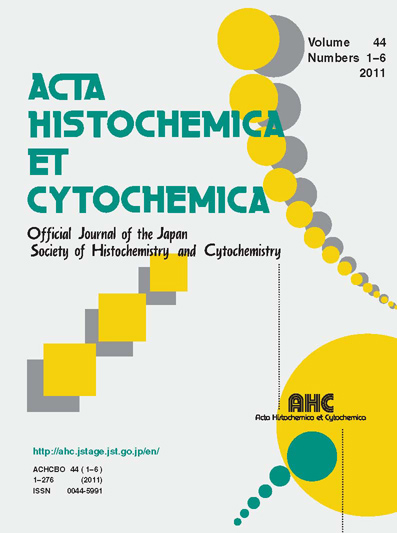All issues

Volume 49 (2016)
- Issue 6 Pages 159-
- Issue 5 Pages 131-
- Issue 4 Pages 109-
- Issue 3 Pages 83-
- Issue 2 Pages 47-
- Issue 1 Pages 1-
Volume 49, Issue 3
Displaying 1-3 of 3 articles from this issue
- |<
- <
- 1
- >
- >|
REGULAR ARTICLE
-
Surang Chomphoo, Wilaiwan Mothong, Tarinee Sawatpanich, Pipatphong Kan ...Article type: Regular Article
2016Volume 49Issue 3 Pages 83-87
Published: June 28, 2016
Released on J-STAGE: June 28, 2016
Advance online publication: June 16, 2016JOURNAL FREE ACCESS FULL-TEXT HTMLEFA6 (exchange factor for ARF6) activates Arf6 (ADP ribosylation factor 6) by exchanging ADP to ATP, and the resulting activated form of Arf6 is involved in the membrane dynamics and actin re-organization of cells. The present study was attempted to localize EFA6 type D (EFA6D) in mouse adrenocortical cells in situ whose steroid hormone secretion is generally considered not to depend on the vesicle-involved regulatory mechanism. In immunoblotting, an immunoreactive band with the same size as brain EFA6D was detected in homogenates of adrenal cortical tissues almost free of adrenal capsules and medulla. In immuno-light microscopy, EFA6D-immunoreactivity was positive in adrenocortical cells and it was often distinct along the plasmalemma, especially along portions of the cell columns facing the interstitium. In immuno-electron microscopy, the gold-labeling was more dense in the peripheral intracellular domains than the central domain of the immunopositive cells. The labeling was deposited on the plasma membranes in a discontinuous pattern and in cytoplasmic domains rich in filaments. It was also associated with some, but not all, of pleiomorphic vesicles and coated pits/vesicles. No labeling was seen in association with lipid droplets or smooth endoplasmic reticulum. The present finding is in support of the importance of EFA6D for activation of Arf6 in adrenocortical cells.View full abstractDownload PDF (989K) Full view HTML -
Minenori Ishido, Tomohiro NakamuraArticle type: Regular Article
2016Volume 49Issue 3 Pages 89-95
Published: June 28, 2016
Released on J-STAGE: June 28, 2016
Advance online publication: June 16, 2016JOURNAL FREE ACCESS FULL-TEXT HTMLAquaporin-4 (AQP4) is a selective water channel that is located on the plasma membrane of myofibers in skeletal muscle and is bound to α1-syntrophin. It is considered that AQP4 is involved in the modulation of homeostasis in myofibers through the regulation of water transport and osmotic pressure. However, it remains unclear whether AQP4 expression is altered by skeletal muscle hypertrophy to modulate water homeostasis in myofibers. The present study investigated the effect of muscle hypertrophy on the changes in AQP4 and α1-syntrophin expression patterns in myofibers. Novel findings indicated in the present study were as follows: 1) Expression levels of AQP4 and α1-syntrophin were stably maintained in hypertrophied muscles, and 2) AQP4 was not expressed in the myofibers containing the slow-type myosin heavy chain isoform (MHC) with or without the presence of fast-type MHC. The present study suggests that AQP4 may regulate the efficiency of water transport in hypertrophied myofibers through its interaction with α1-syntrophin. In addition, this study suggests that AQP4 expression may be inhibited by a regulatory mechanism activated under physiological conditions that induces the expression of slow-type MHC in skeletal muscles.View full abstractDownload PDF (1324K) Full view HTML -
Gazi Jased Ahmed, Eri Tatsukawa, Kota Morishita, Yasuaki Shibata, Fumi ...Article type: Regular Article
2016Volume 49Issue 3 Pages 97-107
Published: June 28, 2016
Released on J-STAGE: June 28, 2016
Advance online publication: June 16, 2016JOURNAL FREE ACCESS FULL-TEXT HTMLThe implantation of biomaterials induces a granulomatous reaction accompanied by foreign body giant cells (FBGCs). The characterization of multinucleated giant cells (MNGCs) around bone substitutes implanted in bone defects is more complicated because of healing with bone admixed with residual bone substitutes and their hybrid, and the appearance of two kinds of MNGCs, osteoclasts and FBGCs. Furthermore, the clinical significance of osteoclasts and FBGCs in the healing of implanted regions remains unclear. The aim of the present study was to characterize MNGCs around bone substitutes using an extraskeletal implantation model and evaluate the clinical significance of osteoclasts and FBGCs. Beta-tricalcium phosphate (β-TCP) granules were implanted into rat subcutaneous tissue with or without bone marrow mesenchymal cells (BMMCs), which include osteogenic progenitor cells. We also compared the biological significance of plasma and purified fibrin, which were used as binders for implants. Twelve weeks after implantation, osteogenesis was only detected in specimens implanted with BMMCs. The expression of two typical osteoclast markers, tartrate-resistant acid phosphatase (TRAP) and cathepsin-K (CTSK), was analyzed, and TRAP-positive and CTSK-positive osteoclasts were only detected beside bone. In contrast, most of the MNGCs in specimens without the implantation of BMMCs were FBGCs that were negative for TRAP, whereas the degradation of β-TCP was detected. In the region implanted with β-TCP granules with plasma, FBGCs tested positive for CTSK, and when β-TCP granules were implanted with purified fibrin, FBGCs tested negative for CTSK. These results showed that osteogenesis was essential to osteoclastogenesis, two kinds of FBGCs, CTSK-positive and CTSK-negative, were induced, and the expression of CTSK was plasma-dependent. In addition, the implantation of BMMCs was suggested to contribute to osteogenesis and the replacement of implanted β-TCP granules to bone.View full abstractDownload PDF (2799K) Full view HTML
- |<
- <
- 1
- >
- >|